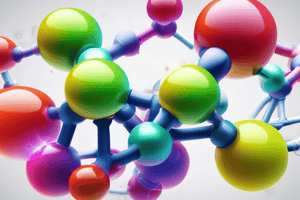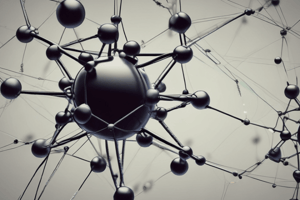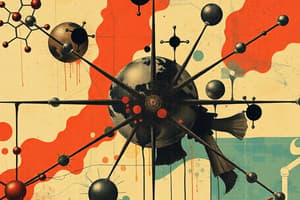Podcast
Questions and Answers
Which of the following is NOT a characteristic of life as described in the text?
Which of the following is NOT a characteristic of life as described in the text?
- Adapting and reproducing
- Exhibiting constant internal temperature regardless of external conditions (correct)
- Maintaining homeostasis
- Being composed of cells
If an atom has 11 protons, 12 neutrons, and 10 electrons, what is its charge?
If an atom has 11 protons, 12 neutrons, and 10 electrons, what is its charge?
- +1 (correct)
- +2
- -1
- 0
Consider a newly discovered organism. It maintains a stable internal salt concentration, even when living in varying saline environments. Which characteristic of life does this BEST exemplify?
Consider a newly discovered organism. It maintains a stable internal salt concentration, even when living in varying saline environments. Which characteristic of life does this BEST exemplify?
- Homeostasis (correct)
- Growth and reproduction
- Requirement for energy
- Response to stimuli
An atom has 6 protons. How many electrons would it likely have in its outermost shell when it is in a neutral state?
An atom has 6 protons. How many electrons would it likely have in its outermost shell when it is in a neutral state?
Which subatomic particle determines the element's identity?
Which subatomic particle determines the element's identity?
Which of the following best describes the relationship between amino acids and proteins?
Which of the following best describes the relationship between amino acids and proteins?
How do enzymes facilitate biochemical reactions within a cell?
How do enzymes facilitate biochemical reactions within a cell?
Which type of lipid is a primary component of cell membranes?
Which type of lipid is a primary component of cell membranes?
What is the primary difference between active and passive transport mechanisms in cells?
What is the primary difference between active and passive transport mechanisms in cells?
If a cell is placed in a hypertonic solution, what will occur?
If a cell is placed in a hypertonic solution, what will occur?
Which of the following molecules is NOT an organic compound?
Which of the following molecules is NOT an organic compound?
A solution has a pH of 3. What does this indicate about the solution?
A solution has a pH of 3. What does this indicate about the solution?
In the structure of DNA, which base typically pairs with guanine?
In the structure of DNA, which base typically pairs with guanine?
During catabolism, complex molecules are broken down into simpler ones. What is typically released during this process?
During catabolism, complex molecules are broken down into simpler ones. What is typically released during this process?
Which of the following is an example of homeostasis in the human body?
Which of the following is an example of homeostasis in the human body?
Flashcards
Life's Requirement
Life's Requirement
Living organisms need energy and raw materials to survive.
Cellular Composition
Cellular Composition
All living things are made up of one or more cells, the basic unit of life.
Homeostasis
Homeostasis
Maintenance of a stable internal environment despite external changes.
Response to Stimuli
Response to Stimuli
Reaction to changes in the environment.
Signup and view all the flashcards
Protons
Protons
Positively charged particles found in the nucleus of an atom.
Signup and view all the flashcards
Atom
Atom
The smallest unit of matter, possessing mass and occupying space.
Signup and view all the flashcards
Element
Element
Pure form of matter that cannot be broken down further, composed of atoms.
Signup and view all the flashcards
Organic Compound
Organic Compound
Compound containing carbon-hydrogen bonds, crucial for life processes.
Signup and view all the flashcards
Protein Denaturation
Protein Denaturation
Proteins lose biological function due to structural change.
Signup and view all the flashcards
Lipids
Lipids
Molecules insoluble in water, including triglycerides, phospholipids, and steroids.
Signup and view all the flashcards
Carbohydrates
Carbohydrates
Compounds with a carbon backbone, hydrogen, and oxygen, used for energy.
Signup and view all the flashcards
Nucleic Acids
Nucleic Acids
Compounds containing carbon, hydrogen, oxygen, nitrogen, and phosphorus; DNA and RNA.
Signup and view all the flashcards
Inorganic Compound
Inorganic Compound
Lacks carbon-hydrogen bond, includes water, salts and gases.
Signup and view all the flashcards
Passive Transport: Diffusion
Passive Transport: Diffusion
Diffusion movement of ion from area of high concentration to low concentration.
Signup and view all the flashcardsStudy Notes
- Living things share key characteristics: requiring energy and raw materials, cellular composition, maintaining homeostasis, response to stimuli, growth, reproduction, and adaptation.
Atomic Structure
- Atoms consist of: negatively charged electrons, positively charged protons, and neutral neutrons.
- Protons and neutrons reside in the nucleus, with electrons orbiting in shells.
- The first electron shell holds a maximum of 2 electrons, while the second can hold more.
- Atoms are the smallest unit of matter.
- Matter is any physical substance with mass that occupies space.
- Elements are pure forms of matter that cannot be broken down further and are composed of atoms.
Organic Compounds
- Proteins are composed of 20 different amino acids.
- Amino acids link via peptide bonds.
- Protein function is determined by its structure and can be disrupted by: denaturation (loss of biological function) and deamination (digestion).
- Lipids are insoluble in water.
- Triglycerides function in energy storage.
- Phospholipids are the primary component of cell membranes.
- Steroids, also insoluble, include cholesterol, vital for animal cell membranes and hormone production (including sex hormones).
- Carbohydrates contain a carbon backbone with hydrogen and oxygen atoms (C, H, O).
- Monosaccharides are simple sugars with 5 or 6 carbon rings.
- Disaccharides consist of two monosaccharides joined by a covalent bond.
- Polysaccharides are long chains of monosaccharides used by cells to store extra energy.
- Nucleic acids contain C, H, O, N, and P and include DNA and RNA.
- Nucleotides are smaller subunits of nucleic acids.
- In DNA, adenine (A) binds with thymine (T), and cytosine (C) binds with guanine (G).
Inorganic Compounds
- Inorganic compounds lack C-H bonds.
- Examples include salts, water, and gases.
Cells
- Cells are the smallest units of life.
- Cells provide basic structure and organization for organisms.
Eukaryotic Cell Organelles
- Eukaryotic cells (human, animal, plant, and fungi cells) possess three main components.
- Plasma membrane: the outer covering.
- Cytoplasm: the region inside the cell, excluding the nucleus.
- Nucleus: the cell's central control center.
Metabolism and Homeostasis
- Metabolism produces energy for cells.
- Homeostasis is an organism's state of internal stability, maintained by adjusting to external changes.
- Homeostasis involves variations within normal limits for factors like heart rate, blood pressure, and blood sugar.
- Water contributes to the properties of life and homeostasis.
- The body maintains homeostasis automatically.
pH Scale
- The pH scale ranges from 0-14, with 7 being neutral.
- Acidic solutions have a pH below 7, while basic solutions have a pH above 7.
- The body functions optimally around a neutral pH of 7.
- Acids are molecules that donate H+ ions in water.
- Bases are molecules that accept H+ ions in water.
- Acids and bases neutralize each other.
Cations vs. Anions
- Cations have a positive (+) electric charge.
- Anions have a negative (-) electric charge.
Tonicity
- Hypotonic solutions have a low osmotic concentration, causing cells to gain water.
- Hypertonic solutions have a high osmotic concentration, causing cells to lose water.
- Isotonic solutions have the same concentration inside and outside the cell, resulting in no net water movement.
Enzymes
- Enzymes are proteins that act as biological catalysts.
- Catabolism involves breaking down molecules.
- Anabolism involves combining molecules.
Passive vs. Active Transport
- Passive transport moves materials along a concentration gradient without energy expenditure.
- Diffusion: movement from high to low concentration.
- Osmosis: movement of water from low to high solute concentration.
- Transport through channels: ions and water diffuse through protein channels in the plasma membrane; water channels are always open, gated channels require specific ionic charges.
- Facilitated transport: molecules bind to membrane proteins for transport (e.g., glucose entering cells).
- Active transport moves molecules against the concentration gradient, requiring energy expenditure.
- Like facilitated transport, it uses membrane proteins, but requires ATP.
- Allows ions to move from low to high concentration.
- Important for digestion; can utilize up to 50% of a cell's ATP.
Studying That Suits You
Use AI to generate personalized quizzes and flashcards to suit your learning preferences.




